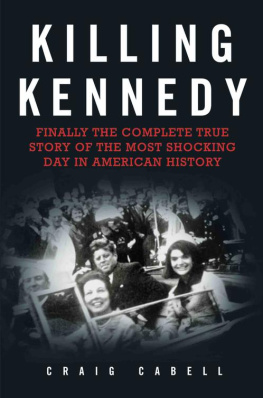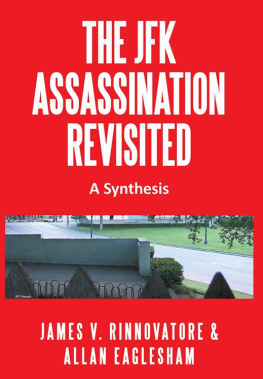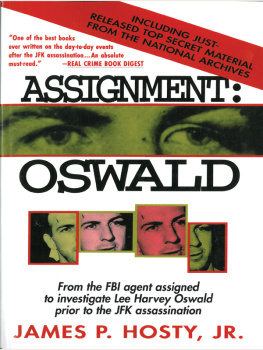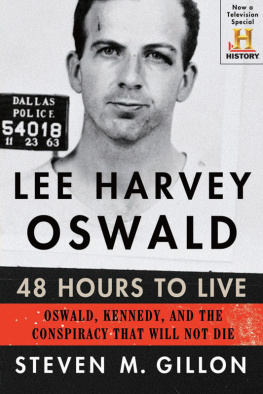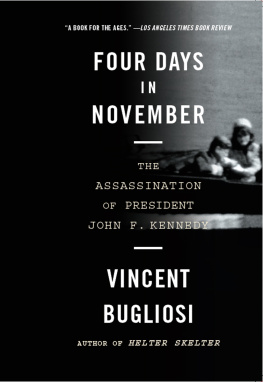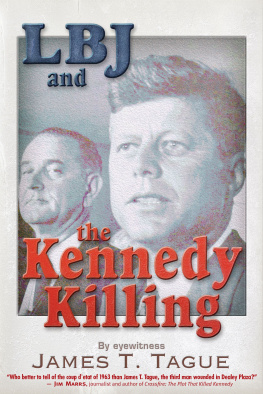The Kennedy Autopsy
The Kennedy Autopsy
By Jacob G. Hornberger
Copyright 2014
The Future of Freedom Foundation
11350 Random Hills Road
Suite 800
Fairfax, Virginia 2203
Table of Contents
Foreword
By Jacob G. Hornberger
I n 1993, Congress established the Assassination Records Review Board (ARRB), whose mission was to secure the disclosure of long-secret federal documents and records relating to the assassination of President John F. Kennedy. The ARRB was formed in response to the public outcry generated by Oliver Stones movie JFK. The main focus of the outcry was the continued secrecy among federal departments and agencies, particularly the military and the CIA, with respect to the Kennedy assassination.
Douglas P. Horne served as Chief Analyst for Military Records for the ARRB. In 2009, Horne authored one of the finest books ever written on the Kennedy assassination, a five-volume work entitled Inside the Assassination Records Review Board: The U.S. Governments Final Attempt to Reconcile the Conflicting Medical Evidence in the Assassination of JFK. Focusing primarily on the U.S. militarys autopsy of President Kennedys body, Hornes book carefully documented how the Kennedy autopsy served to cover up the fact that Kennedy was the victim of a conspiracy, one that consisted of officials within the national-security establishment.
I was so impressed with Hornes book that I wrote a 12-part summary and analysis of it, which was published by The Future of Freedom Foundation, where I serve as president. This ebook consists of that 12-part article plus two other articles I wrote relating to the JFK autopsy.
Contemporaneously with the release of this ebook, The Future of Freedom Foundation is also releasing a video lecture by Horne entitled Altered History: Exposing Deceit and Deception in the JFK Assassination Medical Evidence, which summarizes and updates the findings in Hornes book. I cannot recommend this fascinating video presentation too highly. It is now posted on FFFs website.
We are also releasing another ebook, JFKs War with the National Security Establishment: Why Kennedy Was Assassinated, which consists of a multipart article by Horne that was published by The Future of Freedom Foundation. That ebook explains the motives of the U.S. national-security establishment in removing Kennedy from office.
President Kennedy wrote, The great enemy of the truth is very often not the lie, deliberate, contrived and dishonest, but the myth, persistent, persuasive and unrealistic.
It would be difficult to find a better description of official conclusions reached about the Kennedys assassination than that.
Chapter 1
O n the afternoon of November 22, 1963, one of the most astonishing events in the history of U.S. law enforcement took place at Parkland Hospital in Dallas. It involved a confrontation between agents of the Secret Service and hospital personnel.
After President John F. Kennedy was declared dead at Parkland Hospital, his body was placed into an expensive bronze, ornate casket that had just been ordered and delivered by ONeal Funeral Home in Dallas. Agents of the Secret Service immediately took control over the casket and began removing it from the hospital, over the vehement objections of the Dallas County medical examiner, Dr. Earl Rose, who was the hospitals chief of forensic pathology. Rose told the agents that they werent going anywhere with the casket, at least not until an autopsy had been conducted. Since a murder had just taken place, Texas law required an autopsy to be conducted on the victims body.
The purpose of an autopsy is to determine how the victim was killed. In the ideal case, its conducted by a forensic pathologist, one trained in violent deaths. The pathologist carefully examines the shooting victims body, searches for bullets and removes them, probes bullet holes with rods, has photographs and X-rays taken, and fills out an official autopsy report detailing his findings. In a sense, the victims body is a crime scene, one that must be carefully preserved, examined, and reported on.
What was the Secret Services attitude toward Rose? The agents confronting him clearly had one mission to prevent Texas officials from conducting an autopsy on the presidents body and to get it out of Parkland Hospital immediately and delivered to Dallas Love Field, where it would be immediately flown back to Washington, D.C. In his book Conspiracy of Silence, Dr. Charles Crenshaw, one of the physicians who had attended to the presidents wounds, stated that he had heard the men in suits telling hospital pathologists Vernon Stembridge and Sidney Stewart that they had orders to take the Presidents body back to Washington, D.C., just as soon as it was ready to be moved, that there would be no Texas autopsy.
What jurisdiction did the Secret Service have over the presidents body? None. At that time, it was not a federal offense to assassinate the president. Thus, when Kennedy was shot and killed, the federal government had no jurisdiction over the matter at all. That, of course, included the Secret Service. Nonetheless, the Secret Service agents at Parkland Hospital make it clear to Parkland Hospital officials that they had absolutely no intention of permitting Texas officials to conduct the autopsy required by law. Brandishing guns, they began screaming and yelling for people to get out of their way. When Rose blocked their way, emphasizing to them that Texas law required the autopsy to be conducted, the agents flew into a fit of loud, angry profanities, exposed their guns, and began forcibly pushing people out of the way as they wheeled the casket out of the hospital.
Heres how Crenshaw described this amazing encounter in his book Conspiracy of Silence:
As though on cue, a phalanx of guards poured into Trauma Room 1 just as the coffin was being rolled out. They looked like a swarm of locusts descending upon a cornfield. Without any discussion, they encircled the casket and began escorting the Presidents body down the hall toward the emergency room exit. A man in a suit, leading the group, holding a submachine gun, left little doubt in my mind who was in charge. That he wasnt smiling best describes the look on his face. Just outside Trauma Room 1, Jacqueline [Kennedy] joined the escort and placed her hand on the coffin as she walked along beside it. I followed directly behind them.
When the entourage had moved into the main hall, Dr. Earl Rose, chief of forensic pathology, confronted the men in suits. Roy Kellerman, the man leading the group, looked sternly at Dr. Rose and announced, My friend, this is the body of the President of the United States, and we are going to take it back to Washington.
Dr. Rose bristled and replied, No, thats not the way things are. When theres a homicide, we must have an autopsy.
Hes the President. Hes going with us, Kellerman barked, with increased intensity in his voice.
The body stays, Dr. Rose said with equal poignancy.
Kellerman took an erect stance and brought his firearm into a ready position. The other men in suits followed course by draping their coattails behind the butts of their holstered pistols. How brave of these men, wearing their Brooks Brothers suits with icons of distinction (color-coded Secret Service buttons) pinned to their lapels, willing to shoot an unarmed doctor to secure a corpse.
My friend, my name is Roy Kellerman. I am special agent in charge of the White House detail of the Secret Service. We are taking President Kennedy back to the capitol.
Next page

